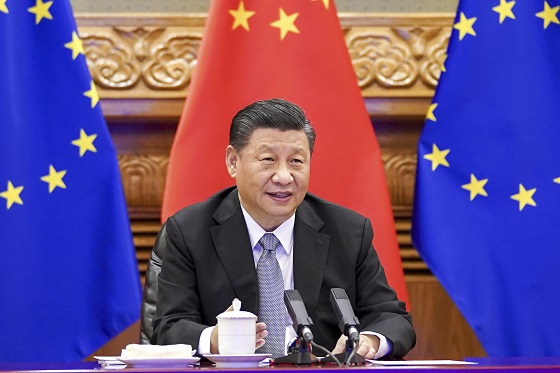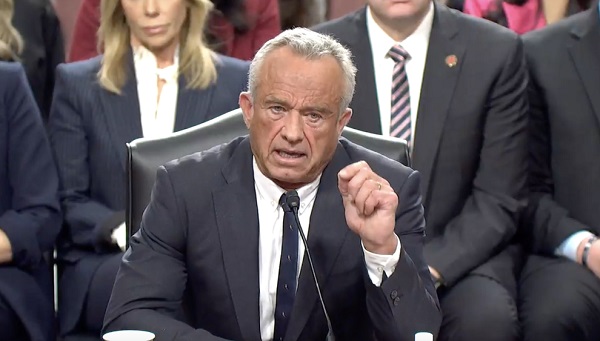International
First-of-its-kind Mars livestream by ESA spacecraft interrupted at times by rain on Earth
CAPE CANAVERAL, Fla. (AP) — A European spacecraft around Mars sent its first livestream from the red planet to Earth on Friday to mark the 20th anniversary of its launch, but rain in Spain interfered at times.
The European Space Agency broadcast the livestream with views courtesy of its Mars Express, launched by a Russian rocket from Kazakhstan in 2003.
It took nearly 17 minutes for each picture to reach Earth, nearly 200 million miles (300 million kilometers) away, and another minute to get through the ground stations.
The transmission was disrupted at times by rainy weather at the deep space-relay antenna in Spain.
Still, enough images made it through to delight the European space officials hosting the hourlong livestream. The initial views showed about one-third of Mars, which gradually grew bigger in the frames before shrinking again as the spacecraft circled the planet. White clouds could clearly be seen in some of the shots.
“If you were currently sitting on board Mars Express … this is what you would be seeing,” said Simon Wood, the mission’s spacecraft operations engineer. “We typically don’t normally get images in this way.”
Pictures and other data usually are stored aboard the spacecraft and later transmitted to Earth, according to Wood, when the spacecraft’s antenna can be pointed this way.
Near real-time footage from so far away is “rather rare,” according to ESA. The agency pointed to the live broadcasts by the Apollo moonwalkers more than a half-century ago and, more recently, live snippets from spacecraft deliberately crashing into the moon and an asteroid.
“These missions were all pretty close to home and others farther away sent perhaps an image or two in near real-time. When it comes to a lengthy livestream from deep space, this is a first,” ESA said in a statement before the event.
The rain on the plains in Spain cut into the number of pictures shown. ESA devoted only an hour to the livestream because it did not want to overload the spacecraft’s batteries.
Mars Express traveled to the red planet with a lander, dubbed Beagle-2, which lost contact with Earth as it attempted to touch down on the Martian surface.
More than a decade later, NASA’s Mars Reconnaissance Orbiter captured pictures of Beagle-2. Although it made it to the surface, the lander’s solar panels didn’t fully unfurl.
___
conflict
Trump tells Zelensky: Accept peace or risk ‘losing the whole country’

 MxM News
MxM News
Quick Hit:
President Donald Trump warned Ukrainian President Volodymyr Zelensky that he risks losing Ukraine entirely if he continues resisting a peace settlement. Trump said Moscow is ready for peace, but Kyiv’s refusal to recognize Crimea as Russian territory could derail the effort.
Key Details:
- Trump said Zelensky “can have Peace or… lose the whole Country” and claimed Russia is ready to make a deal.
- Zelensky reiterated Ukraine’s refusal to recognize Russia’s occupation of Crimea, a key sticking point in current peace talks.
- White House press secretary Karoline Leavitt said Trump is frustrated and warned peace efforts may end if no deal is reached this week.
Diving Deeper:
President Trump issued a blunt warning to Ukrainian President Volodymyr Zelensky on Wednesday, saying the Ukrainian leader must choose between accepting peace or facing the collapse of his nation.
“He can have Peace or… fight for another three years before losing the whole Country,” Trump posted on Truth Social. The statement followed Zelensky’s firm declaration that Ukraine “will not legally recognize the [Russian] occupation of Crimea,” a stance at odds with a proposed peace plan under discussion in London between U.S., British, and European officials.
Trump blasted Zelensky’s comment as damaging, declaring, “Crimea was lost years ago under the auspices of President Barack Hussein Obama, and is not even a point of discussion.” The president added that such rhetoric undermines delicate peace negotiations.
Speaking from the Oval Office, Trump said, “I think Russia is ready,” referring to a peace deal, but questioned whether Ukraine is. Kyiv reportedly signed on to a Trump-proposed ceasefire more than a month ago. Trump hinted that progress has been stymied by Zelensky’s reluctance to compromise.
Despite Russian officials signaling a desire to prolong negotiations—with Kremlin spokesman Dmitry Peskov dismissing Trump’s efforts as “futile”—Trump maintained optimism, stating, “I think we have a deal with Russia… we have to get a deal with Zelensky.”
White House press secretary Karoline Leavitt said Trump’s patience is wearing thin. “President Zelensky has been trying to litigate this peace negotiation in the press, and that’s unacceptable,” she said, calling for closed-door diplomacy. “The American taxpayer has funded billions… enough is enough.”
Trump, 78, has consistently criticized Obama for allowing Russia’s 2014 annexation of Crimea to go unanswered. Now, under the Trump administration’s push for peace, a senior official revealed the U.S. is considering recognizing Crimea as Russian territory—a reversal of longstanding American policy based on the 1940 Welles Declaration.
Still, Trump refrained from criticizing Vladimir Putin directly, instead blaming Zelensky for inflammatory statements. “He has nothing to boast about!” Trump said, referencing a heated Feb. 28 Oval Office exchange with Zelensky and Vice President JD Vance.
“I have nothing to do with Russia,” Trump wrote, “but have much to do with wanting to save… five thousand Russian and Ukrainian soldiers a week.”
Trump warned that time is running out: “We are very close to a Deal, but the man with ‘no cards to play’ should now, finally, GET IT DONE.”
With London talks underway and pressure mounting, officials hinted that if no agreement is reached this week, the U.S. could walk away from its efforts in Eastern Europe. Asked whether Trump is ready to give up, Leavitt said, “Not by the end of the day today… but the President… needs to see this thing come to an end.”
Entertainment
Pedro Pascal launches attack on J.K. Rowling over biological sex views

 MxM News
MxM News
Quick Hit:
Pedro Pascal, star of HBO’s The Last of Us, ignited backlash this week after publicly hurling an expletive-laced insult at author J.K. Rowling in response to her support for a landmark UK ruling that upheld the legal definition of sex as biological. Rowling celebrated the decision, which affirms the rights of women to single-sex spaces—a view shared by many who advocate for the safety and integrity of women’s rights. Pascal, a vocal progressive and LGBTQ+ activist, labeled Rowling a “heinous loser,” aligning himself with calls to boycott HBO’s upcoming Harry Potter reboot.
Pedro Pascal calls J.K. Rowling a “heinous loser” after she celebrated the Supreme Court’s ruling regarding trans women’s legal identities. pic.twitter.com/LEGMD79PjQ
— Pop Base (@PopBase) April 24, 2025
Key Details:
-
Pedro Pascal responded on Instagram to Rowling’s post celebrating a UK court ruling that legally defined “sex” as biological.
-
Pascal echoed an activist’s call for a fan-led boycott of the Harry Potter reboot, saying Rowling’s stance was “heinous LOSER behavior.”
-
HBO has downplayed concerns of a boycott, citing the blockbuster success of Hogwarts Legacy despite similar activist campaigns.
Diving Deeper:
The latest clash in the culture war surrounding Harry Potter author J.K. Rowling and the trans activist movement reached a new level of hostility this week when actor Pedro Pascal, a key face of HBO’s entertainment slate, stooped to name-calling on social media. His remarks came in response to Rowling’s defense of the United Kingdom’s recent court decision, which reaffirmed that sex, under British law, means biological sex—a ruling many women’s rights advocates hailed as a long-overdue step toward protecting vulnerable female spaces such as shelters, hospital wards, and sports.
Rowling, whose views on the importance of distinguishing biological sex from gender identity have made her a target of trans activists for years, posted a pointed but unapologetic reaction: “I love it when a plan comes together.” She added, “I get the same royalties whether you read [my books] or burn them. Enjoy your marshmallows!”
In the comments of a post by activist Tariq Ra’ouf—who had attacked Rowling and promoted a boycott of HBO’s Harry Potter reboot—Pascal added his own vulgar commentary: “Awful disgusting SHIT is exactly right. Heinous LOSER behavior.” While Pascal did not explicitly mention Harry Potter, the post he endorsed included calls to tank all future franchise content, including theme parks and merchandise.
Pascal’s involvement with HBO places the network in a difficult position. As the Emmy-nominated co-lead of The Last of Us, one of HBO’s crown jewels, Pascal’s comments are being widely interpreted as an implicit endorsement of the boycott. While HBO has attempted to downplay the activist push, the tension is palpable. Casey Bloys, HBO’s chief content officer, previously noted that the 2023 video game Hogwarts Legacy, which also faced calls for boycotts due to Rowling’s views, still became the year’s top-selling game.
Pascal’s activism is personal as well as political. His sister, Lux Pascal, publicly transitioned in 2021, and he has frequently signaled support for trans activism. At the UK premiere of Marvel’s Thunderbolts, Pascal wore a shirt that read “Protect the Dolls,” a slogan popularized in trans activist circles.
Rather than “heinous,” Rowling’s remarks represent a reasoned defense of biological reality and a pushback against an increasingly aggressive ideology that demands conformity and punishes dissent. Her critics, like Pascal, resort to vulgarity and character attacks instead of engaging with the substance of her argument. But Rowling has stood firm in supporting women’s rights and advocating for clarity in laws that impact everything from sports to safety in single-sex spaces—positions grounded in truth, not hate.
-

 Business2 days ago
Business2 days agoTrump: China’s tariffs to “come down substantially” after negotiations with Xi
-

 Business2 days ago
Business2 days agoTrump considers $5K bonus for moms to increase birthrate
-

 2025 Federal Election2 days ago
2025 Federal Election2 days agoPolice Associations Endorse Conservatives. Poilievre Will Shut Down Tent Cities
-

 Business1 day ago
Business1 day agoChinese firm unveils palm-based biometric ID payments, sparking fresh privacy concerns
-

 2025 Federal Election2 days ago
2025 Federal Election2 days agoCanada’s press tries to turn the gender debate into a non-issue, pretend it’s not happening
-

 COVID-192 days ago
COVID-192 days agoRFK Jr. Launches Long-Awaited Offensive Against COVID-19 mRNA Shots
-

 2025 Federal Election2 days ago
2025 Federal Election2 days agoNext federal government should end corporate welfare for forced EV transition
-

 2025 Federal Election1 day ago
2025 Federal Election1 day agoConservatives promise to ban firing of Canadian federal workers based on COVID jab status





